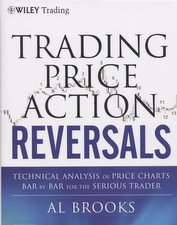TRADING PRICE ACTION REVERSALS
$75.00 Original price was: $75.00.$48.95Current price is: $48.95.
Focuses on how to spot and profit from trend reversals – which offer an excellent risk/reward ratio – using the technical analysis of price action. Learn the various types of reversals and how to best attack each. Includes valuable insight into successfully trading the opening range of a day session.
1 in stock
DESCRIPTION
(From The Jacket) – The key to being a successful trader is finding a system that works and sticking with it. Author Al Brooks, a technical analysis contributor to Futures magazine and an independent trader for twenty-five years, has done just that. Over the course of his career, he’s found a way to capture consistent profits regardless of market direction or economic climate. And now, with his new three-book series — which focuses on how to use price action to trade the markets — Brooks takes you step by step through the entire process.
In order to put his methodology in perspective, Brooks examined an essential array of price action basics and trends in the first book of this series, “Trading Price Action Trends”; provided important insights on trading ranges, breakouts, order management, and the mathematics of trading in the next book, “Trading Price Action Trading Ranges”; and now moves on to discuss trend reversals, day trading, daily charts, options, and the best setups for all time frames in this third, and final, book of the series, “Trading Price Action Reversals”.
Divided into four comprehensive parts, “Trading Price Action Reversals” skillfully addresses how to spot and profit from trend reversals — which offer an excellent risk-reward ratio — using the technical analysis of price action. Along the way, it touches on some of the most essential aspects of this approach as well as several other important topics, including:
- The various types of reversals, their specific characteristics, and how to select the proper ones
- Capturing profits by successfully trading the “first hour,” or more accurately, the opening range of a day session
- Using price action to effectively incorporate options into your trading strategies
- Guidelines that can help keep traders on track and put them in a better position to make more informed trades and trade management decisions
- Specific price action setups that new traders should focus on
- And much more
Throughout the book, Brooks focuses primarily on 5 minute candle charts — all of which are created with TradeStation — to illustrate basic principles, but also discusses daily and weekly charts. And since he trades more than just E-mini S&P 500 futures, Brooks also details how price action can be used as the basis for trading stocks, forex, Treasury Note futures, and options. For your convenience, a companion website, which can be found at wiley.com/go/tradingreversals, contains all of the charts provided in the book.
Trading is a rewarding endeavor, but it’s hard work and requires relentless discipline. To succeed, you have to stick to your rules and avoid emotion — and you have to patiently wait to take only the best trades. “Trading Price Action Reversals”, the final piece of this three-book set, will help you achieve this goal. With this guide, and the other two books in the series, you’ll discover how to develop the patience and discipline to follow a sound system, and reap potentially huge financial rewards in the process.
TABLE OF CONTENTS
PART 1: Trend Reversals: A Trend Becoming An Opposite Trend
- Chapter 1 – Example Of How To Trade A Reversal
- Chapter 2 – Signs Of Strength In A Reversal
- Chapter 3 – Major Trend Reversal
- Chapter 4 – Climactic Reversals: A Spike Followed By A Spike In The Opposite Direction
- Chapter 5 – Wedges And Other Three-Push Reversal Patterns
- Chapter 6 – Expanding Triangles
- Chapter 7 – Final Flags
- Chapter 8 – Double Top And Bottom Pullbacks
- Chapter 9 – Failures
- Chapter 10 – Huge Volume Reversals On Daily Charts
PART 2: Day Trading
- Chapter 11 – Key Times Of The Day
- Chapter 12 – Markets
- Chapter 13 – Time Frames And Chart Types
- Chapter 14 – Globex, Premarket, Postmarket, And Overnight Market
- Chapter 15 – Always In
- Chapter 16 – Extreme Scalping
PART 3: The First Hour (The Opening Range)
- Chapter 17 – Patterns Related To The Premarket
- Chapter 18 – Patterns Related To Yesterday: Breakouts, Breakout Pullbacks, And Failed Breakouts
- Chapter 19 – Opening Patterns And Reversals
- Chapter 20 – Gap Openings: Reversals And Continuations
PART 4: Putting It All Together
- Chapter 21 – Detailed Day Trading Examples
- Chapter 22 – Daily, Weekly, And Monthly Charts
- Chapter 23 – Options
- Chapter 24 – The Best Trades: Putting It All Together
- Chapter 25 – Trading Guidelines
| publication_year | 2012 |
|---|---|
| product_type | Hardcover |
| pages | 550 |
| writer | Al Brooks |
| orig_products_id | 769 |



